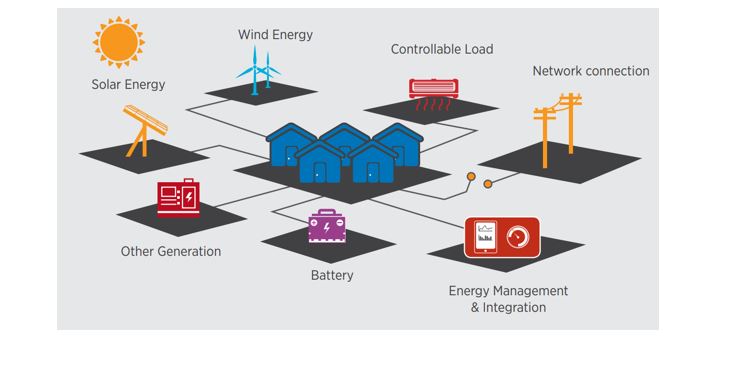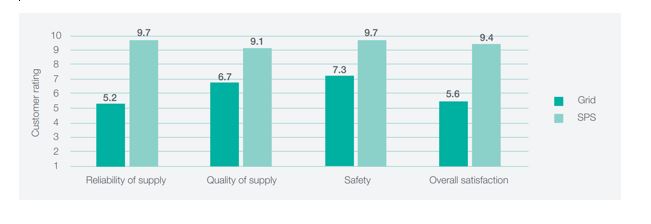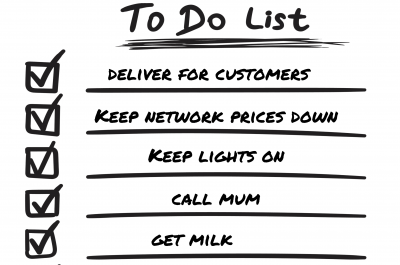Edge of grid, end of line?
The electricity grid represents 100 years of effort and investment to ensure Australians have easy access to electricity at the flick of a switch. The grid was first built in central business districts, then expanded to areas further away. Today, you won’t find many populated areas without poles and wires. Electrification and grid expansion across urban and regional Australia, “electrifying the state” was an historic driver of Australia’s economic development – but today, the economics are changing.
Improvements in technology are paving the way for cheaper alternatives at the ‘edge of the grid’ – where there are smaller numbers of customers, usually far from urban centres. An off-grid supply arrangement comprising local renewable generation and battery storage, known as a stand-alone power system (SAPS), is becoming more viable, both from a reliability and cost perspective, for customers where once the best way to supply electricity was through traditional poles and wires.
Figure 1: A stand-alone power system[1].

Benefits: numerous and widespread
Transitioning specific grid-connected customers to a SAPS is likely to result in improved outcomes for all.
These power systems are cheaper than the cost of installing and maintaining traditional poles and wires, creating savings for distribution businesses and lower bills for customers.
Western Power has estimated more than 2700 customers in its Western Australian network could be moved to SAPS for a net customer benefit of $388m[2]. Essential Energy estimates a similar move for its network would deliver a net benefit of $513m[3]. Other electricity networks across the country servicing remote areas have also identified that off-grid supply makes economic sense in some areas. Across Australia, the benefits are clearly in the billions of dollars.
The customer benefits don’t stop at cost savings. Most rural and remote customers are connected to the grid by long power lines. These long wires are much more likely to be impacted by wind, rain, vegetation and lightning. If the line trips, it can be difficult for the distribution business to identify where the fault is, making it costly and time consuming to fix. With a SAPS, fixing such a problem is generally cheaper and faster as the fault is contained locally.
Off-grid experience
In 2016, Western Power piloted SAPS for 40 customers towards the end of long lines. These customers experienced a significant reliability improvement between the pilot period of July 2016 and June 2017, with an average outage duration of just 4.66 hours versus 69.59 hours had the customers been grid connected. The systems were also shown to be robust enough to survive extreme weather events.
Customers’ experiences were enhanced with a SAPS, preferring a SAPS to their previous grid supply[4].
Figure 2: Customer satisfaction of Standalone Power Supply (SPS)

Sounds good, right?
Despite networks and other stakeholders agreeing SAPS are a more cost-efficient overall supply solution for certain customers, the existing regulations are not designed to support them.
Western Power in 2016 submitted a rule change to the Australian Energy Market Commission (AEMC) requesting that SAPS be included within the definition of distribution services as an alternative to grid supply. The rule change was not progressed, with the AEMC noting that a broader package of changes to laws was required to protect consumers and properly implement the reform. These reforms have now crystallised, with the AEMC releasing an issues paper proposing regulations for implementing a SAPS framework.
Distribution businesses should be given the flexibility to provide grid-connected customers with SAPS when they are the least-cost solution and offer reliability benefits. They have the expertise and capacity to efficiently deliver these services to remote and regional communities.
The distribution business would identify possible customers, set up a SAPS and decommission the redundant poles and wires. The customers transitioning to SAPS would retain their reliability standards and would be served at a lower cost, creating long-term savings for all customers.
Previous decisions by the AEMC have had unintended detrimental market outcomes. Metering competition reform was meant to increase competition, bring prices down and provide more customer choice – but that clearly has not been the case. We do not want a similar situation where championing competition for the sake of it leads to failed objectives – especially at the edges of the grid where the lack of population makes effective competition highly unlikely. We want regulations that support reduced customer costs when there are easy savings to be made.


